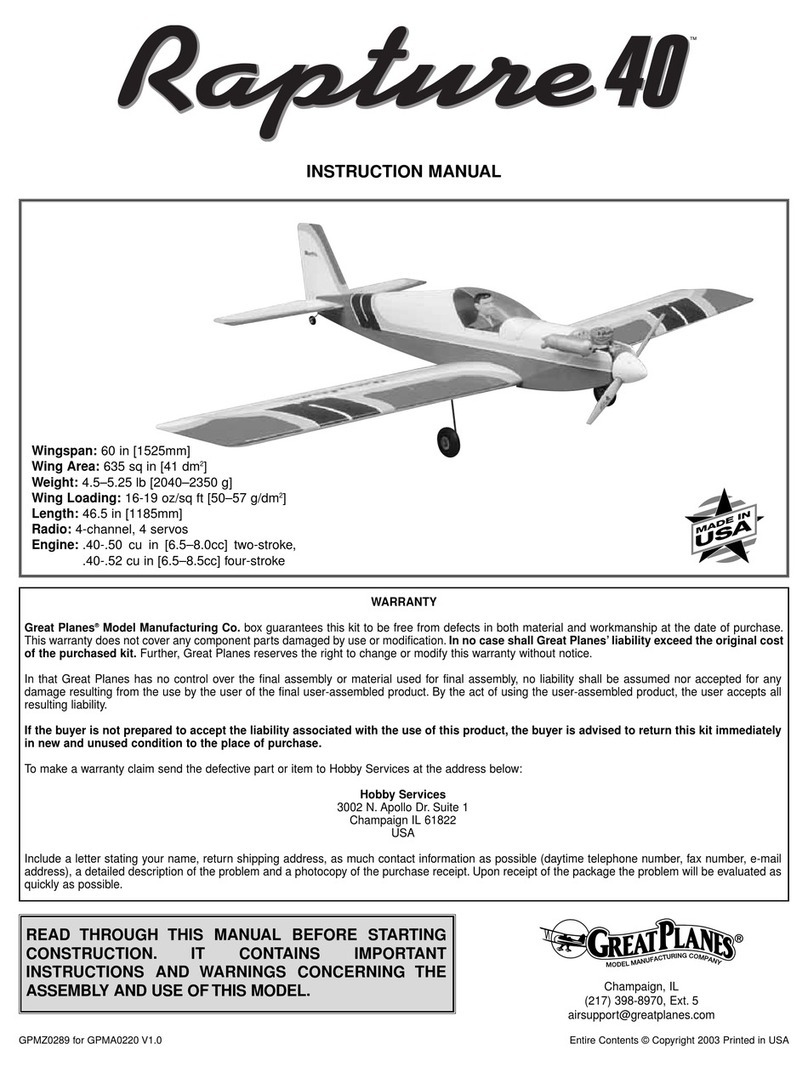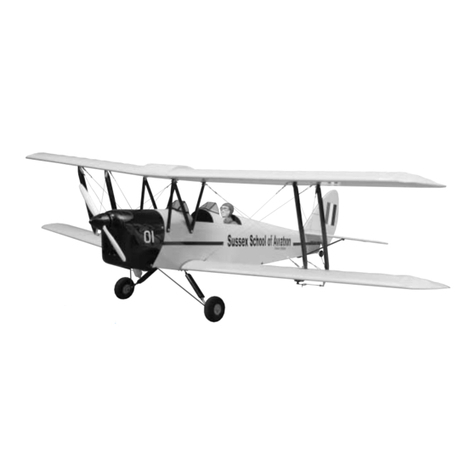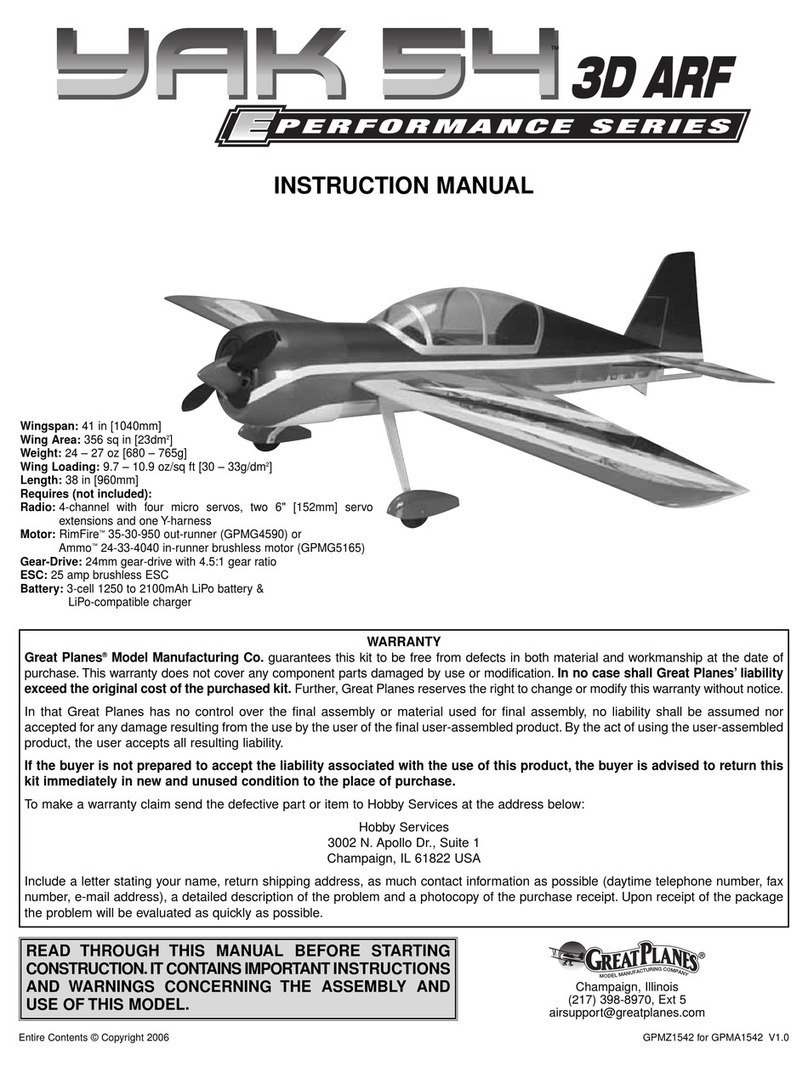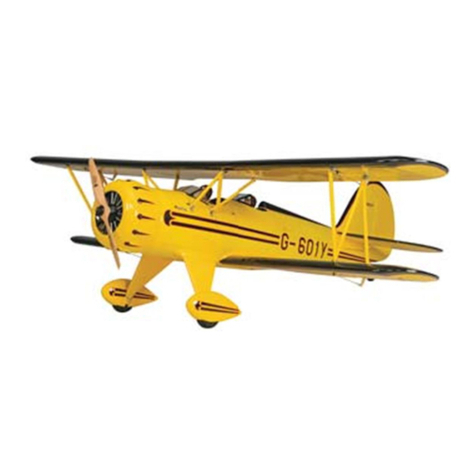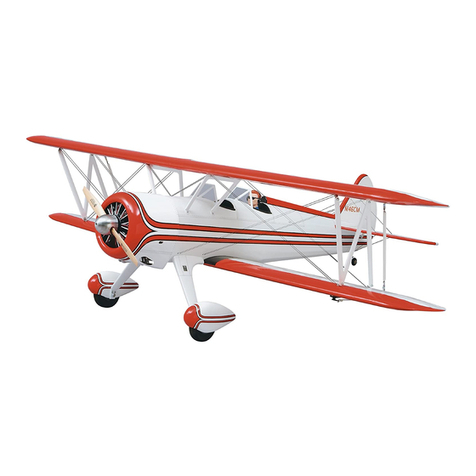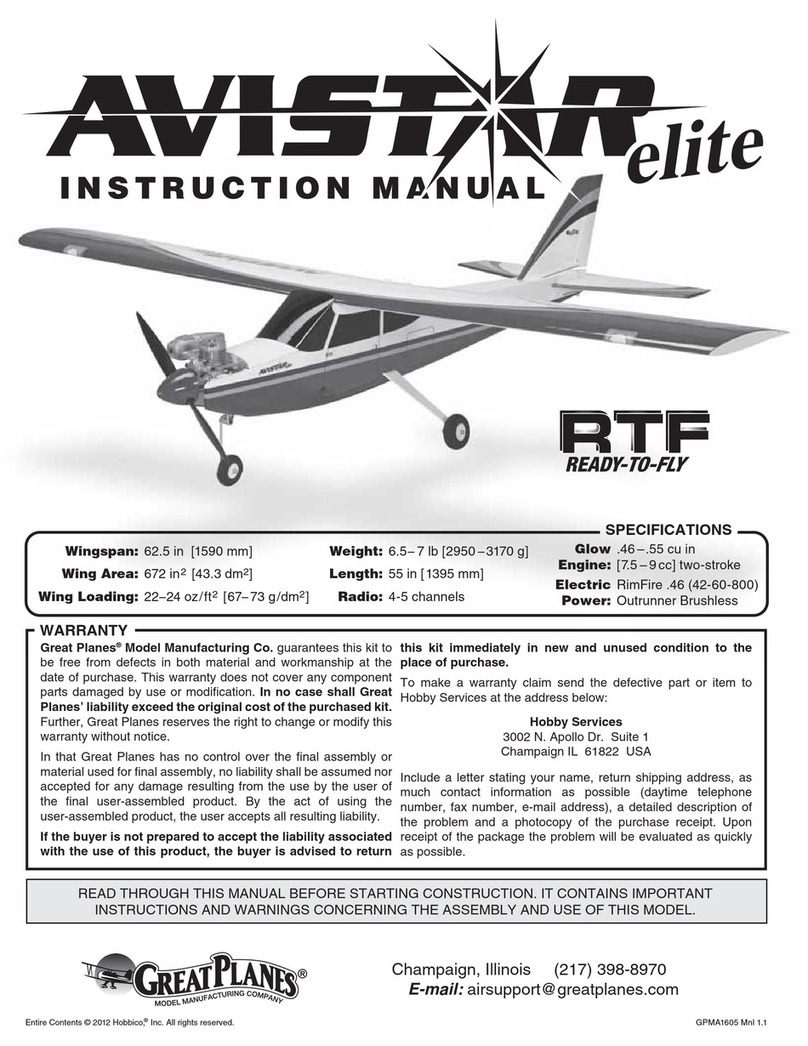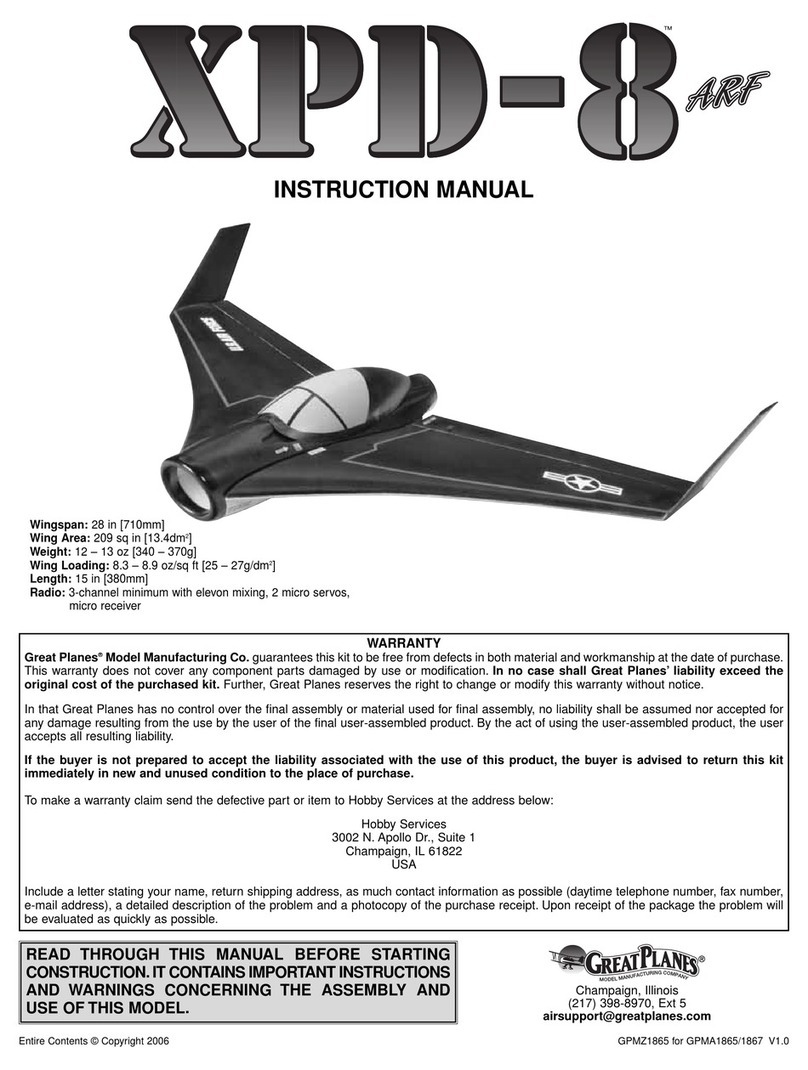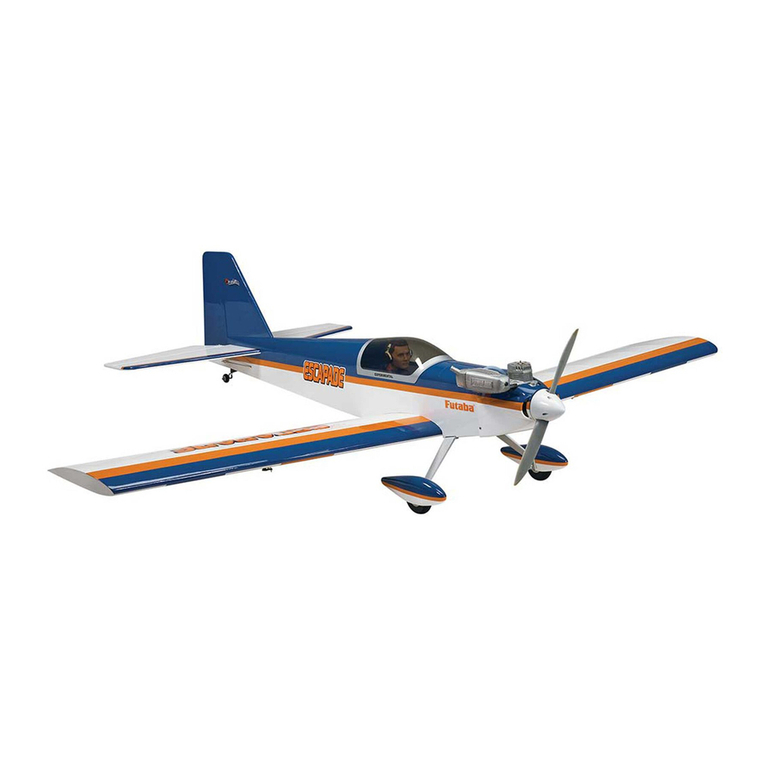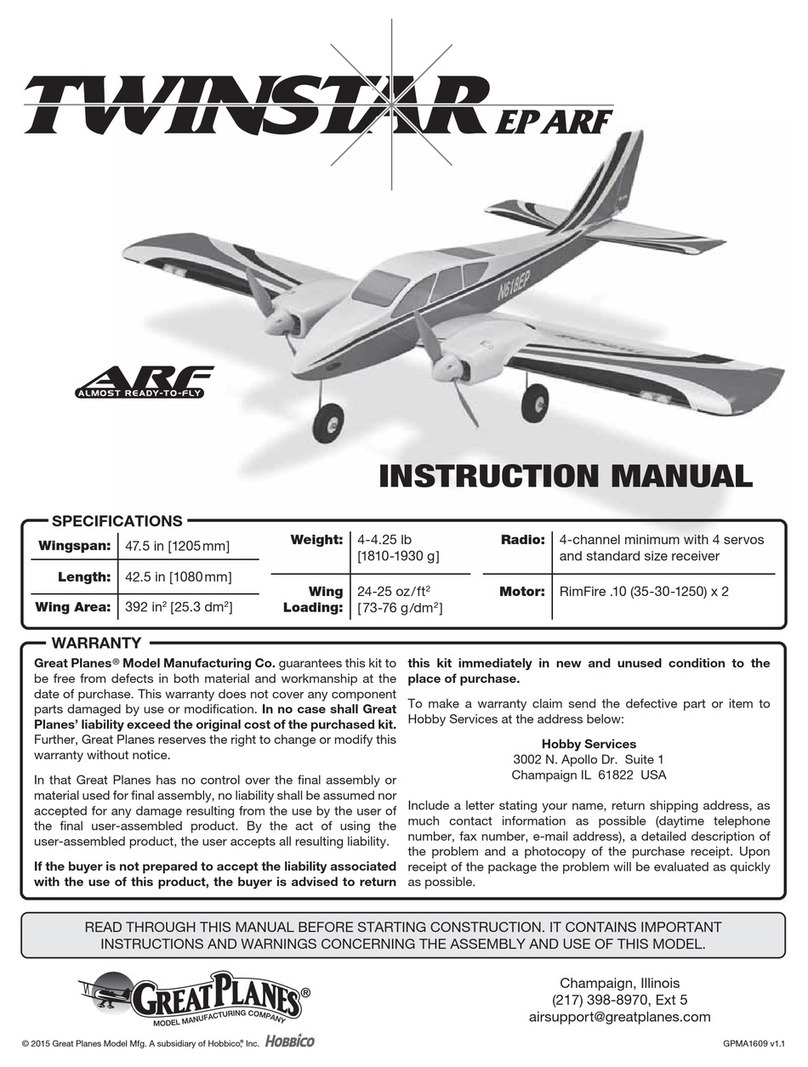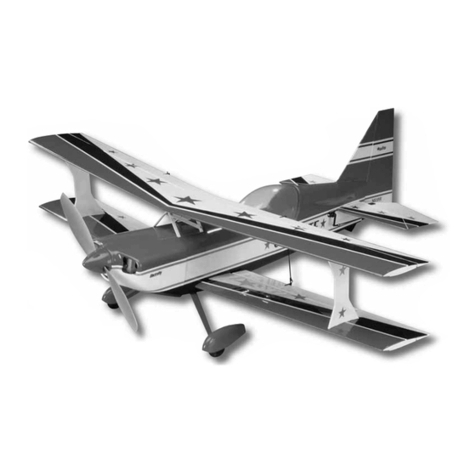
2
INTRODUCTION
Originally built by the Granville Brothers Aircraft of Springfield,
Massachusetts in 1932, the Gee Bee R1 won the Thompson
Trophy race that same year. It also set a new landplane world
speed record of 296mph (476 km/h) in the Shell Speed Dash.
But, the Gee Bee R1 quickly gained a reputation for being
difficult to fly and dangerous. The Great Planes Gee Bee
EP Rx-R has been designed to eliminate the dangerous
flight characteristics, creating an easy to fly, great looking,
sport plane.
For the latest technical updates or manual corrections to the
Gee Bee EP Rx-R visit the Great Planes web site at www.
greatplanes.com. Open the “Airplanes” link, then select the
Gee Bee EP Rx-R. If there is new technical information or
changes to this model a “tech notice” box will appear in the
upper left corner of the page.
Academy of Model Aeronautics
If you are not already a member of the AMA, please join! The
AMA is the governing body of model aviation and membership
provides liability insurance coverage, protects modelers’ rights
and interests and is required to fly at most R/C sites.
Academy of Model Aeronautics
5151 East Memorial Drive
Muncie, IN 47302-9252
Tele. (800) 435-9262
Fax (765) 741-0057
Or via the Internet at: http://www.modelaircraft.org
IMPORTANT!!! Two of the most important things you can
do to preserve the radio controlled aircraft hobby are to avoid
flying near full-scale aircraft and avoid flying near or over
groups of people.
SAFETY PRECAUTIONS
Protect Your Model, Yourself & Others…
Follow These Important Safety Precautions
1. Your Gee Bee EP Rx-R should not be considered a toy,
but rather a sophisticated, working model that functions very
much like a full-size airplane. Because of its performance
capabilities, the Gee Bee Rx-R, if not assembled and operated
correctly, could possibly cause injury to yourself or spectators
and damage to property.
2.You must assemble the model according to the instructions.
Do not alter or modify the model, as doing so may result in an
unsafe or unflyable model. In a few cases the instructions may
differ slightly from the photos. In those instances the written
instructions should be considered as correct.
3. You must take time to build straight, true and strong.
4.You must use an R/C radio system that is in good condition
and other components as specified in this instruction manual.
All components must be correctly installed so that the model
operates correctly on the ground and in the air. You must
check the operation of the model and all components before
every flight.
5. If you are not an experienced pilot or have not flown this type
of model before, we recommend that you get the assistance
of an experienced pilot in your R/C club for your first flights.
If you’re not a member of a club, your local hobby shop has
information about clubs in your area whose membership
includes experienced pilots.
6. While this kit has been flight tested to exceed normal
use, if the plane will be used for extremely high stress flying,
such as racing, or if a motor is used that is stronger than the
one included, the modeler is responsible for taking steps to
reinforce the high stress points and/or substituting hardware
more suitable for the increased stress.
TABLE OF CONTENTS
INTRODUCTION . . . . . . . . . . . . . . . . . . . . . . . . . . . . . . . . 2
Academy of Model Aeronautics . . . . . . . . . . . . . . . . . . 2
SAFETY PRECAUTIONS . . . . . . . . . . . . . . . . . . . . . . . . . 2
DECISIONS YOU MUST MAKE . . . . . . . . . . . . . . . . . . . . 3
Recommended Batteries . . . . . . . . . . . . . . . . . . . . . . . 3
Radio . . . . . . . . . . . . . . . . . . . . . . . . . . . . . . . . . . . . . . 3
Recommended Charger . . . . . . . . . . . . . . . . . . . . . . . 3
Optional Replacement Prop. . . . . . . . . . . . . . . . . . . . . 3
ADDITIONAL ITEMS REQUIRED. . . . . . . . . . . . . . . . . . . 3
Adhesives and Building Supplies. . . . . . . . . . . . . . . . . 3
Optional Supplies and Tools . . . . . . . . . . . . . . . . . . . . 3
KIT INSPECTION . . . . . . . . . . . . . . . . . . . . . . . . . . . . . . . 3
ORDERING REPLACEMENT PARTS . . . . . . . . . . . . . . . 4
KIT CONTENTS. . . . . . . . . . . . . . . . . . . . . . . . . . . . . . . . . 4
HORIZONTAL STABILIZER INSTALLATION . . . . . . . . . 5
INSTALL THE MAIN LANDING GEAR. . . . . . . . . . . . . . . 6
RADIO SETUP. . . . . . . . . . . . . . . . . . . . . . . . . . . . . . . . . . 6
INSTALLATION OF THE FLYING WIRES . . . . . . . . . . . . 9
BALANCE THE MODEL (C.G.) . . . . . . . . . . . . . . . . . . . 10
Balance the Model Laterally . . . . . . . . . . . . . . . . . . . 11
PREFLIGHT . . . . . . . . . . . . . . . . . . . . . . . . . . . . . . . . . . . 12
Identify Your Model . . . . . . . . . . . . . . . . . . . . . . . . . . 12
Charge the Batteries . . . . . . . . . . . . . . . . . . . . . . . . . 12
Balance Propellers. . . . . . . . . . . . . . . . . . . . . . . . . . . 12
Ground Check and Range Check . . . . . . . . . . . . . . . 12
MOTOR & BATTERY SAFETY PRECAUTIONS . . . . . . 12
LITHIUM BATTERY HANDLING & USAGE . . . . . . . . . . 12
AMA SAFETY CODE EXCERPTS . . . . . . . . . . . . . . . . . 13
General . . . . . . . . . . . . . . . . . . . . . . . . . . . . . . . . . . . 13
Radio Control. . . . . . . . . . . . . . . . . . . . . . . . . . . . . . . 13
CHECK LIST . . . . . . . . . . . . . . . . . . . . . . . . . . . . . . . . . . 13
FLYING. . . . . . . . . . . . . . . . . . . . . . . . . . . . . . . . . . . . . . . 14
Takeoff . . . . . . . . . . . . . . . . . . . . . . . . . . . . . . . . . . . . 14
Flight . . . . . . . . . . . . . . . . . . . . . . . . . . . . . . . . . . . . . 14
Landing . . . . . . . . . . . . . . . . . . . . . . . . . . . . . . . . . . . 14

